
Highway 22 is an east–west state highway in the Arkansas River Valley. It is maintained by the Arkansas State Highway and Transportation Department (AHTD). The highway runs 75.60 miles (121.67 km) from US 64/US 71B east to Highway 7 in Dardanelle. Following the historic stagecoach line of the cross-country Butterfield Trail, the highway is one of the original 1926 state highways. It is designated by the AHTD as the True Grit Trail.
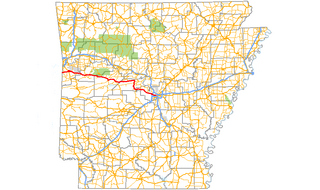
Arkansas Highway 10 is an east–west state highway in West Arkansas. The route runs 135.41 miles (217.92 km) from Oklahoma State Highway 120 near Hackett east to Interstate 30 in Little Rock, the state's capitol. The highway serves both the Fort Smith metropolitan area and the Little Rock – North Little Rock – Conway metropolitan area.
Walker House, and variations including Walker Homestead and Walker Barn, may refer to:

Fort Logan H. Roots was a military base located in North Little Rock, Arkansas, set on a high promontory overlooking the Arkansas River. The land was traded to the Federal Government in 1892 in exchange for the property now known as MacArthur Park, in Little Rock, which had been a military arsenal since the 1830s when Arkansas was a territory. The base was named for Congressman Logan H. Roots in recognition for his work in the negotiations.

U.S. Route 64 is a U.S. highway running from Teec Nos Pos, Arizona east to Nags Head, North Carolina. In the U.S. state of Arkansas, the route runs 246.35 miles (396.46 km) from the Oklahoma border in Fort Smith east to the Tennessee border in Memphis. The route passes through several cities and towns, including Fort Smith, Clarksville, Russellville, Conway, Searcy, and West Memphis. US 64 runs parallel to Interstate 40 until Conway, when I-40 takes a more southerly route.

The Pioneer House is a historic house on Hospital Drive in Clarksville, Arkansas. It is a 1 1⁄2-story structure, partly built of logs and partly of wood framing, covered by a gabled roof and weatherboard siding. The eastern portion is built out of logs joined by dovetailed notches. A 1982 dendrochonological study of the logs used estimated the structure was likely originally built in 1850 and the style and methods used suggested the builders were of European descent. It is one of the oldest surviving buildings in the Clarksville and Johnson County region.
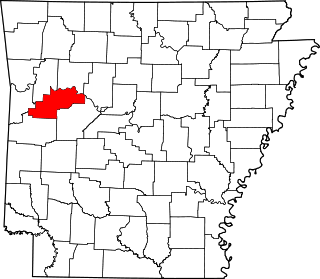
This is a list of the National Register of Historic Places listings in Logan County, Arkansas.

The American Legion Post No. 121 is a historic social hall on Legion Hut Road in southern Paris, Arkansas. It is a single-story L-shaped structure, built out of notched logs on a stone foundation. The logs are painted brown, and are mortared with white cement. It has a gabled roof with exposed rafter ends. A gabled porch shelters the front entrance, supported by square posts set on concrete piers faced in stone. The building was constructed in 1934 with work crews funded by the Works Progress Administration, and is the best local example of WPA Rustic architecture.
Highway 116 is a designation for two east–west state highways in Logan County. A northern route of 3.40 miles (5.47 km) runs east from Highway 23 encircling the northeastern quadrant of Booneville and ending at Highway 10. A second route of 1.02 miles (1.64 km) begins at Highway 23 and runs east to the Booneville Human Development Center.

The Taylor Log House and Site is a historic plantation site on Arkanasas Highway 138 in rural Drew County, Arkansas, near the town of Winchester. Included on the plantation site is the best-preserved dog trot house in Arkansas's Lower Delta region. The Taylor Log House, a two-story dog trot built out of cypress logs, was built in 1846 by John Martin Taylor, a Kentucky native who established a plantation on the banks of Bayou Bartholomew. The building was moved, probably in the 1880s. In addition to the house, the site is believed to include archeologically significant remnants of a wide variety of outbuildings. The site was the subject of archeological activities in the 1990s.

The Averitt House is a historic house in the rural central part of Miller County, Arkansas. It is a single-story log structure, located about 7 miles (11 km) south of Texarkana on the west side of United States Route 71. It was built in 1931-33 by Tom Averitt, the local health inspector at the time, and is a locally unique example of rustic log architecture. It is roughly L-shaped, with a shed-roof porch on its northeastern facade. A single fieldstone chimney rises through the roof near the junction of the L. The walls are made of unfinished logs joined by saddle notches. The logs for its construction were supposedly taken by clearing the site on which it stands. Not far from the house stands a garage, also built by Averitt from logs.
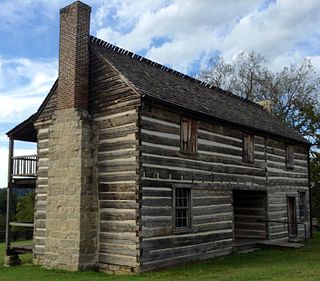
The Jacob Wolf House is a historic house on Arkansas Highway 5 in Norfork, Arkansas. It is a log structure, built in 1825 by Jacob Wolf, the first documented white settler of the area. Architecturally it's a "saddle bag", which is a two-story dog trot with the second floor built over the open breezeway. A two-story porch extends on one facade, with an outside stair giving access to the upper floor rooms. The building's original chinking has been replaced by modern mortaring. It is maintained by the Department of Arkansas Heritage as a historic house museum.

The Drennen-Scott House is a historic house museum on North 3rd Street in Van Buren, Arkansas. It is a single-story log structure, finished in clapboards, with a side-gable roof that has a slight bell-cast shape due to the projection of the roof over the front porch that extends across the width of its main block. The house was built in 1836 by John Drennen, one of Van Buren's first settlers. Drennen and his brother-in-law David Thompson were responsible for platting the town, and Drennen was politically active, serving in the territorial and state legislatures, and at the state constitutional convention. The house remained in the hands of Drennen descendants until it was acquired by the University of Arkansas at Fort Smith, which operates it as a house museum.
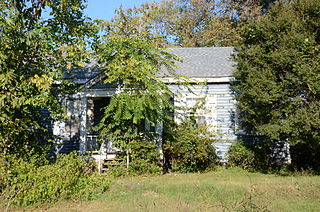
The Wilhauf House is a historic house at 109 North 3rd Street in Van Buren, Arkansas. Built in 1838 and restyled in 1847, it is one of the oldest surviving buildings in the state. It is a single story log dog trot structure, consisting of two log pens originally joined by a breezeway. The house is sheathed in weatherboard, and has a modest Greek Revival gabled portico. The 1847 alterations included the extension of the gable roof to accommodate additional rooms in the rear, which have been furthered extended by a modern addition. The house was built by Leonard Wilhauf on land he purchased from John Drennan, Van Buren's first proprietor.

The Sam Marshall House is a historic house in rural Searcy County, Arkansas. It is located southeast of Morning Star, on the west side of County Road 163. It is a single-story log structure, rectangular in plan, with a roof whose front gable extends over a porch supported by square columns. The logs were apparently hand-hewn, and joined by dovetailed notches. Built in 1929, it is one of the latest examples of log construction in the county.

The Joe Emmer House was a historic house in rural northern White County, Arkansas. It was located on County Road 47, northwest of the Holly Springs Church. It was a single-story single-pen log structure, with a side gable roof and a shed-roof porch across the front. The logs were hand-hewn and joined by dovetailed notches. A frame addition extended the building to the west. The house was built c. 1890, and was one of about thirty such houses remaining in the county.

Plummer's Station is a historic house on Gap Creek south of Plumerville in Conway County, Arkansas. Built about 1830 and altered several times since, it is one of the oldest surviving structures in the county. At its core is a log cabin, built by Samuel Plummer, and served as a stop on the stagecoach route between Little Rock and Fort Smith in the 19th century. The building is currently falling apart due to a lack of funding to repair it. As it sits this historical site will not last much longer. In appearance it is now an L-shaped single-story structure, sheathed in clapboards.

Park Hill is a historic house at 400 East Wahl Street in Paris, Arkansas. It is a large two-story brick building, with Mediterranean style. It has a red tile hip roof, with a three-bay porch projecting from its five-bay facade, and a porte cochere on the west side. The house was built in 1929-30 as a wedding present from Charles Wahl to his wife, and was designed by Bassham and Wheeler of Fort Smith, Arkansas. It is a distinctive local example of the Mediterranean Revival style.

The Dr. Stephen N. Chism House is a historic house in rural Logan County, Arkansas. It is located north of Booneville, on the east side of Arkansas Highway 23 about 0.5 miles (0.80 km) south of its junction with Arkansas Highway 217. It is a two-story log dogtrot house, with two log pens flanking an open breezeway, with a gable roof for cover. Built about 1844–45, it is believed to be the oldest log building in the county. Log Builder Paul Glidewell completed the complete restoration of the house in late 2013.
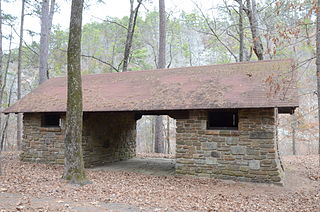
The Jack Creek Bathhouse is a historic recreational facility in Ouachita National Forest, Logan County, Arkansas. It is located south of Booneville, at the Jack Creek Recreation Area in the northern part of the national forest. It is a single-story masonry structure, built out of rustic stone, with a gabled roof supported by logs. It has two dressing rooms, separated by an open breezeway. It was built in 1936 by a crew of the Civilian Conservation Corps, and is a well-preserved example of the Rustic architecture the CCC is well known for producing.



















